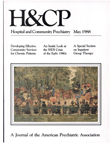Mitral Valve Prolapse and the Anxiety Disorders
Abstract
Confusing and contradictory resuits have emerged from studies of the relationship between anxiety disorders and mitral valve prolapse (MVP), a commonly occurring heart defect that has been associated with chest pain, palpitations, tachycardia, and arrhythmias. Patients with anxiety disorders, particularly panic at- tacks, appear to have an increased prevalence of MVP compared with control groups or the general population, although most individuals with MVP are asymptomatic. MVP does not appear to distinguish a subgroup of patients with panic disorder on the basis of vulnerability to panic attacks, symptom presentation, biological abnormalities, or treatment response. The authors review some current hypotheses about causal relationships between anxiety disorders and MVP, describe methods of diagnosing MVP and their shortcomings, and identify possible medi- cal complications of MVP and ways to treat or prevent them.
Access content
To read the fulltext, please use one of the options below to sign in or purchase access.- Personal login
- Institutional Login
- Sign in via OpenAthens
- Register for access
-
Please login/register if you wish to pair your device and check access availability.
Not a subscriber?
PsychiatryOnline subscription options offer access to the DSM-5 library, books, journals, CME, and patient resources. This all-in-one virtual library provides psychiatrists and mental health professionals with key resources for diagnosis, treatment, research, and professional development.
Need more help? PsychiatryOnline Customer Service may be reached by emailing [email protected] or by calling 800-368-5777 (in the U.S.) or 703-907-7322 (outside the U.S.).



